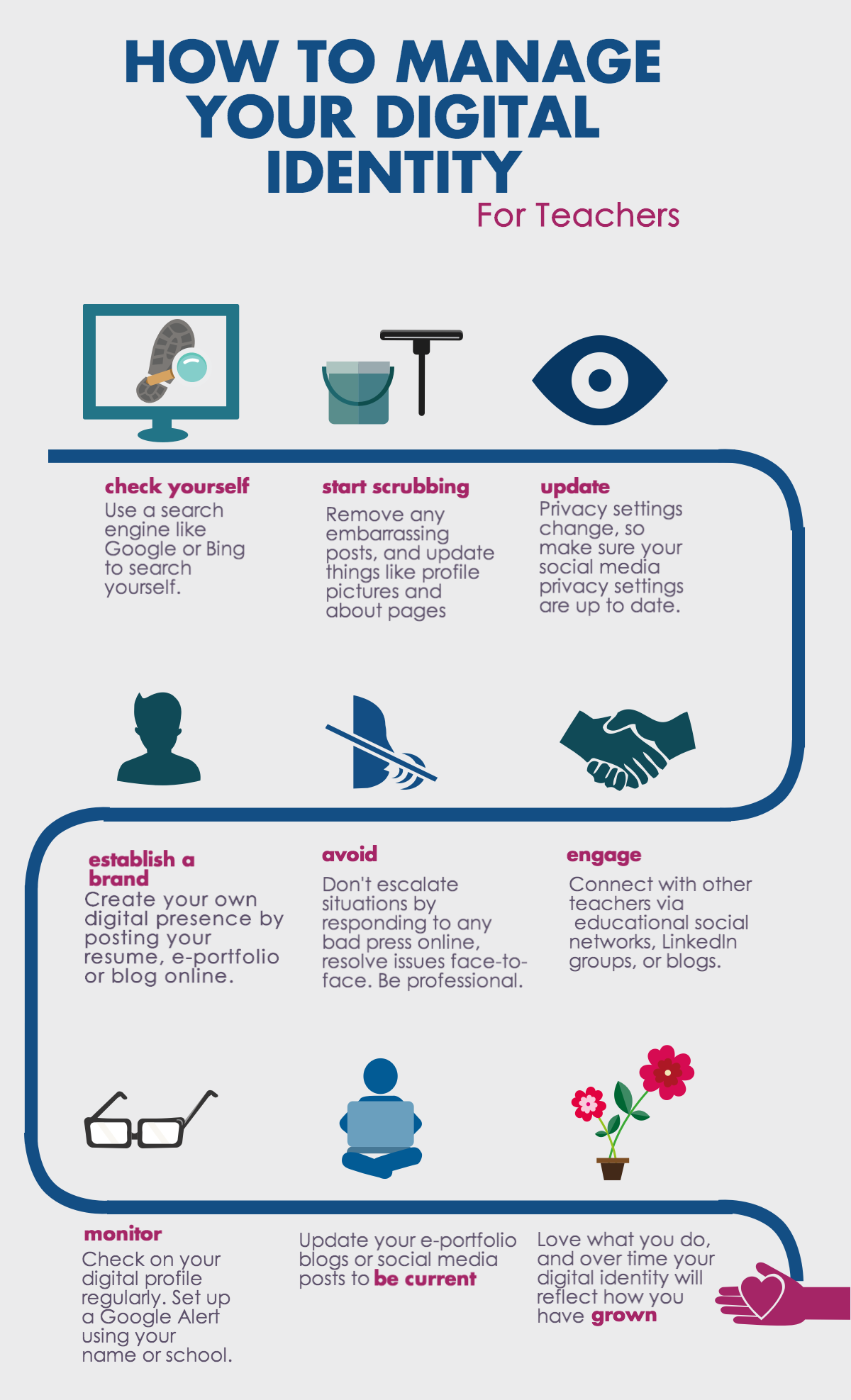Privacy Concerns Specific to Teacher’s E-Portfolios
Privacy is an important consideration for young people entering the workplace, and particularly for young teachers. When putting an e-portfolio online for lifelong learning purposes, personal reflection, or as a part of a course, teachers may have the option of securing their information in a password protected website or learning management system. However, like everyone else, teachers should be aware of privacy issues which are associated with computer use and internet access. These privacy protection issues revolve around things such as, data mining, web tracking, avoiding spyware and unauthorized access to your computer to collect data. This data, inadvertently left behind by internet users, it is referred to as a passive digital footprint.
| ▸ Check the University of British Columbia’s Digital Tattoo site’s section covering online protection (CC BY-SA 4.0). |
If a purpose of the teacher’s e-portfolio is to showcase work in order to optimize job opportunities, teachers will need to consider privacy concerns with internet use, as well as concerns about personal information related to their online presence. They will need to think about who will be looking at their information, what information should be made accessible, and to safe guard their own personal identity information, which could be misused. And, of course, care should always be taken to ensure the privacy of their students. When personal data is released intentionally by a user for the purpose of sharing information via social media or websites, it is referred to as an active digital footprint.
Digital Footprint, and Digital Identity
Data from a user’s digital footprint constructs the user’s digital identity. The Canadian government’s definition of a digital identity is “an identity developed in the online environment that can be accessed, used, stored, transferred or processed by means of electronic or computer devices or systems (2013).”
| ▸ As you watch the video below, think about how digital footprint shapes digital identity. |
Teachers, Social Media and Digital Identity
An individual’s digital identity can impact how they are perceived by others. This can potentially impact many areas of their lives, ranging from personal relationships to education and job opportunities. Often teachers face more scrutiny due to social expectations for them to maintain a higher levels of professionalism. The issues which can be most problematic for teachers are ones concerning their active digital footprint — primarily by their use of social media.
| ▸ Click on the yellow dots, which appear when you scroll over interactive graphic below, to learn more about online privacy and social media issues impacting teachers. |
Not having an online presence can be just as detrimental as having a damaged online presence. However, as a teacher’s career progresses, the likelihood of not having an online presence diminishes due to the fact that a teacher’s digital identity can be influenced by what others put online — which is beyond their control. For example, teachers may not be able to control content on their school or institution’s website, or students may use sites like Rate My Professors.
▸ Take a moment to consider (or discuss in your classroom) the following questions:
|
Managing Digital Identity
Teachers need to be cognizant of their own roles in shaping their digital identities, as opposed to leaving it to chance or in someone else’s hands. There are a number of things teachers can do when they are creating their digital identity and online presence and e-portfolios. For example, the e-portfolio can be hosted on an LMS, or a website that can be password protected or include password protected access for content including personal or other sensitive information. (See E-Portfolio Platforms and Services for details on e-portfolio hosting options.) Teachers can gain skills in using social media more deliberately and responsibly. In addition, more social networks specifically designed for teachers are being used because teachers feel safer and can still maintain professional relationships.
| ▸ Take a look at the following infographic for more suggestions on managing digital identity. |
Recommended Resources
- How To Optimize Your Online Presence (For Job Hunts) by Michael Poh
- Digital Tattoo by the University of British Columbia
- A Great Guide on Teaching Students About Digital Footprint by Educational Technology and Mobile Learning
- Design Your Digital Tattoo: Helping Students Build Their Digital Image by the International Society for Technology in Education)
Bibliography
- Digital Footprint. (n.d.). In Wikipedia. Retrieved April 9, 2015 from: http://en.wikipedia.org/wiki/Digital_footprint
- Industry Canada, Digital Policy Branch. (2013). Protecting and managing digital identities online. Retrieved from the Industry Canada website: https://www.ic.gc.ca/eic/site/ecic-ceac.nsf/eng/gv00585.html
- International Society for Technology in Education. (2013). Design your digital tattoo: Helping students build their digital image. YouTube. Retrieved from: https://youtu.be/Y1OKLLzuZso
- Jake Vale Films. (2013). Social media experiment. YouTube. Retrieved from: https://www.youtube.com/watch?v=5P_0s1TYpJU
- Leadinginnovation. (2011). Dos and don’ts when using social networks. YouTube. Retrieved from: https://www.youtube.com/watch?v=hqezbib5qpQ
- Logan, R., and Walker, T. (2012) Is it time to scrub your digital identity? National Education Association. Retrieved from: http://neatoday.org/2012/09/07/is-it-time-to-scrub-your-digital-identity-2/
- Simpson, Mike. (2010). Social networking nightmares: Cyberspeak no evil. National Education Association. Retrieved from: http://www.nea.org/home/38324.htm
- Tomassini, Jason. (2013). Social networks for teachers on the rise as popular social media raise concerns. HuffPost Education Group. Retrieved from: http://www.huffingtonpost.com/2013/01/08/teachers-gravitate-to-soc_n_2433747.html
- Web20Classroom Blog. (n.d.). Teachers, take care of your digital footprint. TeachHUB. Retrieved from: http://www.teachhub.com/teachers-digital-identity

 Follow
Follow